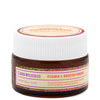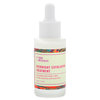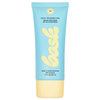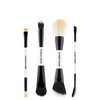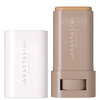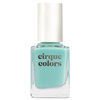
Sometimes washing makeup off can make you feel better than applying it. But those who prefer rinse-free beauty get permanent makeup on their face, a cosmetic procedure that tattoos the skin to enhance facial features. Unfortunately, this area of the industry is often clouded with misconception and fallacy, so we turned to Marjorie Grimm, a permanent cosmetic specialist and member/publicist of the Society of Permanent Cosmetic Professionals (SPCP), to help demystify the topic.
How is permanent makeup different than traditional body art?
People often confuse permanent makeup tattoo pigments with ones used for traditional body art, but there are some vital differences. “Body art tattoo pigments are often more vibrant and concentrated, but pigments formulated by the SPCP pigment manufacturer suppliers are intentionally formulated to appear softer in order to emulate conventional makeup,” says Marjorie. The SPCP pigment suppliers are also required to list the ingredients on the pigment label. “Skin is a living canvas, so technicians need to know the complete ingredient listing to predict the most accurate results on each client’s unique coloring.”
And like any tattoo, pigment fades on the skin. Because your face gets more sun exposure and the pigment is already formulated for a softer appearance, permanent makeup may fade even faster than regular tattoos. The frequency of touch-ups depends on your coloring and SPF regimen, and client maintenance can greatly enhance the longevity of a procedure.
But what about those scary photos we’ve all seen of brows gone wrong and weirdly lined lips? “People who have not selected a professional, and possibly worked with an unskilled, untrained person offering permanent cosmetic services without credentials or experience, will pass along stories that are uncomplimentary to our industry,” says Marjorie. “People who’ve worked with skilled technicians, however, tell you permanent makeup is the best thing they’ve ever done for themselves—in fact, they ask themselves what took them so long!”
Who is the ideal client?
While women can turn to permanent makeup as an alternative to daily application, the type of clients and treatments vary drastically. Those suffering from alopecia (clinical loss of hair) or who have undergone chemotherapy benefit from the psychological effects of the services offered by a professional permanent cosmetic technician. Experienced technicians can also expertly camouflage severe scars and can even re-pigment the areolae on breast cancer survivors.
And the desire to look good doesn’t seem to have an age limit. Those more mature are just as concerned with their appearance as younger women are, but many face problematic dexterity and eyesight issues. The majority of permanent cosmetic clients are over 40, and some are in their eighties or nineties. More mature women typically tattoo their brows, eye liner, and lip line, while more youthful Beauties go for subtle brow and lash enhancements. “Ethical technicians recognize that taste changes with age, so they’ll usually limit the services offered to young people,” explains Marjorie. Men are also popular clients, and use this procedure to cover scars and enhance lashes and brows.
How do you find the right technician?
If you’re potentially interested, what do you do next? The first and sometimes hardest step is finding a highly qualified technician. Consider this as important as finding your next doctor or dentist. “Since regulations [for permanent makeup] vary from state to state, it’s vital that you learn as much as possible about the industry,” urges Marjorie. A good place to begin searching for a qualified technician is on the SPCP referral site. Consider their training, experience, portfolio, and adherence to safety and state/local regulations. Once you find a technician you feel meets these criteria, visit their facility for a consultation before you schedule any procedures. While there, ask yourself these questions:
1. Is the space clean?
Is there hot and cold running water aside from in the restroom? Is the work being done in a private room where other contaminants, such as acrylic nail dust, cannot circulate in the air? The Centers for Disease Control and Prevention (CDC) set standards for physical cleanliness and a sanitary working environment, which SPCP members should strictly follow.
2. Is the technician sanitary?
Do they use new gloves for every client? Is there evidence of client protection such as plastic coverings for the procedure bed and barriers for the machine? Are the technician's nails clean and short? Most important, do they use new sterile needles and machine accessories with each client? Does the technician use a Sharps container to properly dispose of used needles?
3. What is their background?
How long have they been in the industry and how many procedures have they performed? Can they show you their certificates of training? Ask newer technicians how many hours of training they have had. Do they have a business license?
4. Do you like their work?
Look at the technician's portfolio—does their work agree with your personal preferences? Do you like the style in which he or she applies the makeup?
5. Are they equipped to do work on lips and scars?
Lip work, in Marjorie's opinion, is a more advanced procedure than eye liner or brows. Survey portfolios closely and meet with an experienced technician. “If you have a history of cold sores, your technician should recommend a doctor consultation to determine if an antiviral medication is appropriate before proceeding,” advises Marjorie. Scar camouflage also requires a very precise eye and extensive training.

Marjorie Grimm is a Health Department-permitted permanent cosmetic specialist and member of the Society of Permanent Cosmetic Professionals. She enters her 18th year of business, focused exclusively on permanent cosmetics. She is also a published author and respected educator, sharing her expertise and knowledge with the entire permanent cosmetic industry.
You Might Also Like
-

Expert Advice
4 Surprising Curly Hair Myths
- 346
-

Expert Advice
Coordinate Your Lipstick with Your Winter Coat
- 62
-

Expert Advice
What's Your Winter Scent?
- 77
-
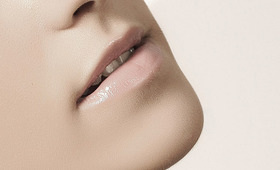
Expert Advice
Which Nude Is Right for You?
- 432
-

Hair
DIY Hair Care From Your Pantry!
- 1115
-

Expert Advice
Would You Permanently Tattoo Your Makeup?
- 50
-
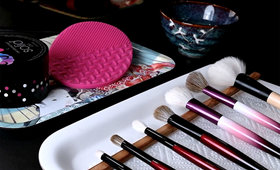
Makeup Brushes
The Definitive Guide on How To Clean Your Brushes
- 4
-

Tips & Tricks
Get Hair Like Edward and Bella
- 644



 Marjorie Grimm is a Health Department-permitted permanent cosmetic specialist and member of the Society of Permanent Cosmetic Professionals. She enters her 18th year of business, focused exclusively on permanent cosmetics. She is also a published author and respected educator, sharing her expertise and knowledge with the entire permanent cosmetic industry.
Marjorie Grimm is a Health Department-permitted permanent cosmetic specialist and member of the Society of Permanent Cosmetic Professionals. She enters her 18th year of business, focused exclusively on permanent cosmetics. She is also a published author and respected educator, sharing her expertise and knowledge with the entire permanent cosmetic industry.


